| |
Tuesday, February 19, 2008, 1:07 PM GeneralPosted by stefanie I turn 33 this June. According to the Japanese age system, I'm already there and therefore in need of protection. For women, 33 is a major yakudoshi, or "age of calamity," as one reading of the number 33, san-zan, means "horrible" or "difficult." (For men, the age of major calamity is 42 because one reading of the number, shi-ni, is a homophone for the Japanese word for "death.") The year before ( maeyaku) and the year after ( atoyaku) one's yakudoshi are also unlucky years. So basically, the most unlucky years of my life span the entire time we're living in Japan. Awesome. My yakudoshi luck made itself apparent at noon on Sunday. A few weeks ago, I had signed up to participate in our area shrine's yakudoshi ceremony. Two hours before the ceremony, a couple of the community leaders came to the house with the following explanation for how things would go down: "You'll be first because you're the only thirty-three-year-old. Also, and we're really, really sorry for the late notice, but could you give a speech? It can be easy! We're really sorry to tell you this now. Thank you so much. Did we mention that we're sorry about springing this on you two hours before the ceremony?" One frenzied phone call to my Japanese teacher and a consultation with the neighbors across the street later, I had a short, sweet speech prepared. At the ceremony, a Shinto priest prayed for the good health and fortune of the people celebrating their yakudoshi.  Members of the community gave those of us participating in the ceremony red hats after the blessing. 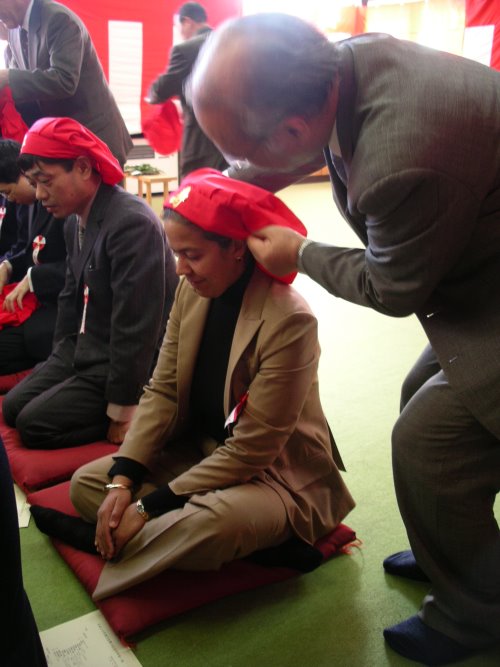 Once the ceremony had concluded, the community members and celebrants had a party with lots of drinking, eating, and well-wishing. My speech went very smoothly, perhaps helped along by the well-wishers plying me with beer. The community leaders made the forty-two-year-olds and me (and Matthew, just for kicks) dance a traditional dance. 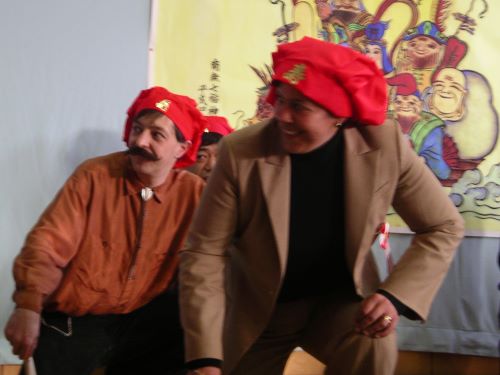 It was a very special day, and we had a great time.
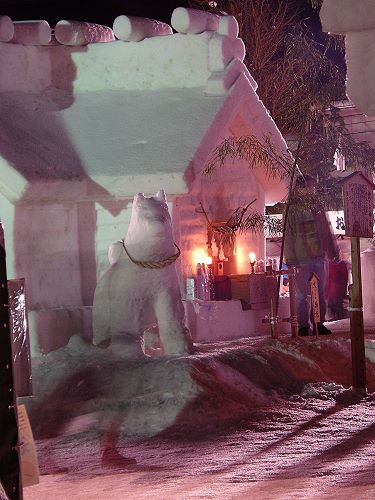 A giant snow dog stands as a guardian against thieves from the spirit world. By chance, it seems the camera even captured a ghostly thief in the foreground.
Here's another manhole cover, this time from Yuzawa. You can see Inukko Matsuri represented by the dog and shrine in the lower right corner. 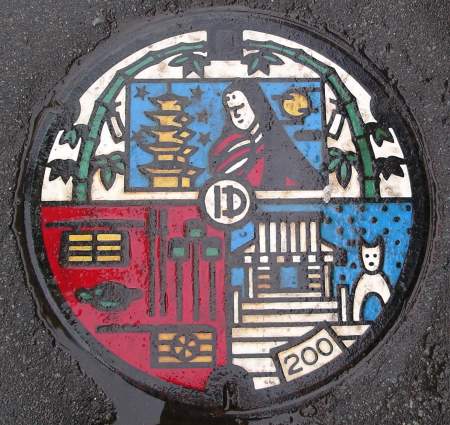
What could possibly say "Happy Valentine's Day" better than two cans of beer? How about two cans of beer decorated with a ribbon and a rhinestone heart? 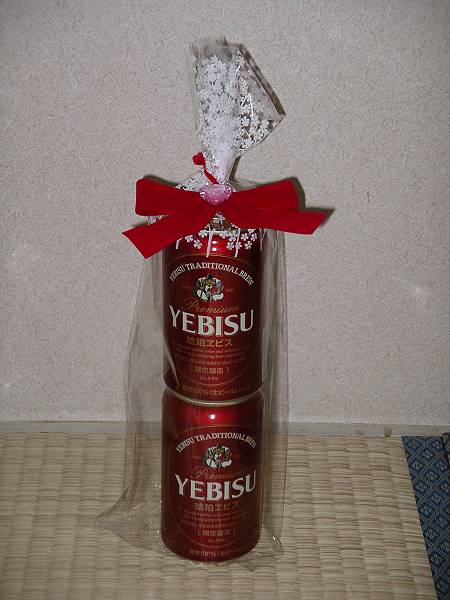
These lanterns dotted the hillside in a park overlooking Inukko Matsuri, in Yuzawa City, Akita. 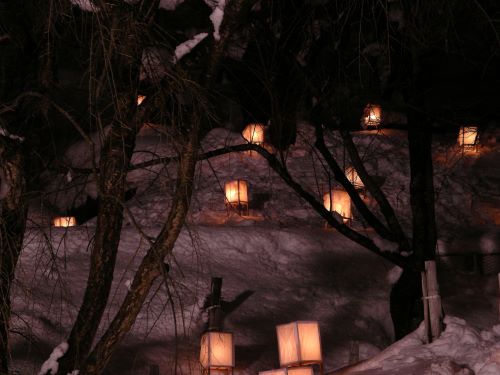
Yaki = Grilled = Food... Right?
At Inukko Matsuri, we decided to enjoy some of the festival food for dinner. But what to have? Pretty much every food item available was something yaki - grilled or fried. There was takoyaki (octopus in fried balls of batter), yakiniku (grilled beef skewers), okonomiyaki (fried pancake with toppings), ikayaki (grilled squid), yakizakana (grilled fish), yakisoba (fried noodles) with or without medamayaki (fried egg), yakimochi (grilled mochi), yakitori (grilled chicken skewers), and yakidango (grilled rice flour balls). Other foods such as nabeyaki udon (fried noodle hot-pot), sukiyaki (simmered morsels), teriyaki (meat or chicken with a sweet sauce) and yakiimo (grilled sweet potato) were not represented at the festival. As we considered our options, we saw a tent set off from the others a little ways, advertising dondoyaki. What kind of food might that be? We'd never heard of it, but thought it would be best to check it out before deciding what to eat. As we approached the tent, it became apparent that food was not involved. They actually seemed to be collecting pine branches. Then it dawned on us that yaki isn't just for food - it also means burning things. In fact, they were collecting new year's decorations to burn in a bonfire as part of a Shinto ceremony. 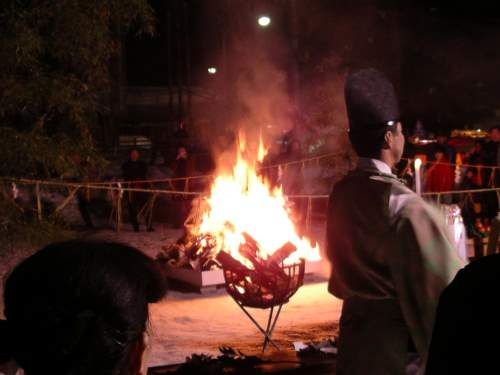 Needless to say, we opted for some of the other yakis for dinner.
Tuesday, February 12, 2008, 12:03 AM General, DogsPosted by stefanie This weekend was Inukko Matsuri in Yuzawa City, Akita Prefecture. Inukko Matsuri, the "Little Dog Festival," dates back to the Edo Period (about 400 years). It is said that the festival originated after the feudal lord of what is now Yuzawa City defeated a clan of thieves. To protect their homes against future thievery, the townspeople put small dogs ( inukko) made of rice flour in the entryways and windows of their homes. For the matsuri, groups build shrines out of snow, at the altars of which they place candles, offering boxes, and inukko. 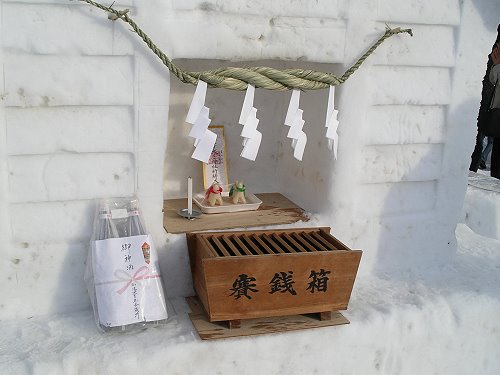 The shrines have much larger guardians as well: 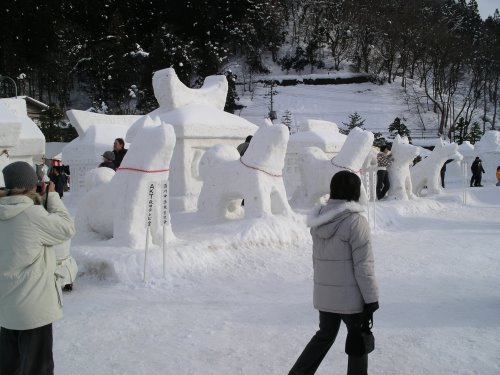 At night, the shrines and dogs are lit by candles, giving the whole park where the festival is held a magical, wondrous feeling. 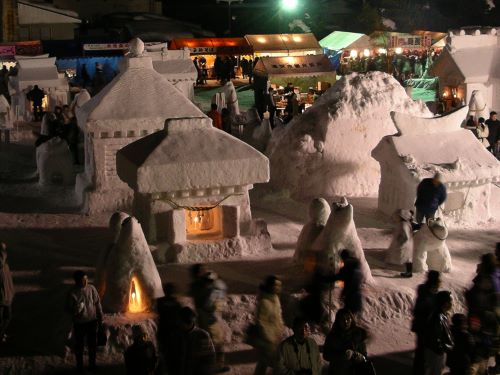
Saturday, February 9, 2008, 1:17 AM GeneralPosted by stefanie "Who do you like: Clinton or Obama?"
Over the last couple of weeks, this question has come up a few times. Especially this week, after Super Tuesday, when more people have asked us our views. People in Kitakami are clearly watching the American presidential race this year.
Clinton and Obama are far and away the names that people ask us about most often. We read American news sources every day, so we're very aware that the American media highlights their historical significance as presidential candidates. It appears from talking to people here that Japanese media is focusing on that aspect of the presidential race as well. As a result, the Republican candidates hardly register at all. Most people don't even ask about them. During a discussion about the election, one person was able to name McCain and Giuliani, but knew nothing about the other Republicans. He only vaguely knew about John Edwards. It will be interesting to see whether people ask more about the Republican candidate once both parties have chosen their nominees.
In the interest of keeping the blog's focus on our lives in Japan, please do not comment on the candidates in the comments section.
[ 1 comment ] permalink
Tuesday, February 5, 2008, 9:49 PM FoodPosted by stefanie "Who can take a bean curd, shape it in a square,
Fry a flattened piece until it's gold and light as air?
The Tofu Man, the Tofu Man can."
Many apologies to Mr. Davis Jr. for appropriating his song, but really, I feel like our local tofu shop is magic. You know that scene in "Charlie and the Chocolate Factory" (the one with Gene Wilder) when Charlie finds the dollar in the street and goes into the candy shop, staring around at the chocolate in astonishment? That's how I feel going into the tofu shop with my 160 yen. "One Creamy Awesome Cotton Tofu Delight, please."
Tofu shop tofu is, in a word, amazing. We had some last week, topped with seasoned miso and grilled, and it was quite possibly the best tofu we'd ever eaten, all savory and earthy. Later on, I bought an aburaage, or sheet of deep-fried tofu. Now, supermarket aburaage comes in perfect, tasty rectangles of pale blonde. Tofu shop aburaage, on the other hand, is individually shaped, deep golden, not at all greasy, and tastes fantastic.
The tofu shop staff is also quite wonderful. They're chatty and helpful, happily answering my questions about which tofu will work best in which dishes. We're very glad we finally tried the place, having gone past it probably hundreds of times before we even noticed it. Yay, tofu shop!
[ 5 comments ] permalink
Yesterday was Setsubun, the day before the beginning of the "spring season" in Japan. Setsubun is a day akin to New Year's, when people engage in rituals to chase evil away from their homes and bring good fortune in during the year. The most famous ritual is mamemaki, or "bean throwing." Mamemaki involves the head of the household throwing beans out the door of the home at someone dressed as a demon, while the family members chant: " Oni wa soto! Fuku wa uchi!" ("Demons out! Good luck in!"). You're also supposed to eat one bean for each year of your life to bring good luck. Here in Kitakami, stores were selling peanuts to be used for mamemaki, rather than soybeans. We didn't do mamemaki at home (scaring demons away is why we have big fuzzy dogs), but we did partake in the ritual of eating ehomaki at Hige-oyaji's place. This tradition allegedly originated in the Kansai region, but has spread to other areas of Japan. Ehomaki is a fat sushi roll (called futomaki on non- Setsubun days). If you can eat the entire uncut roll while praying, and without speaking, it is believed that you will have good fortune throughout the year. You eat the ehomaki while facing the eho (direction of good fortune) for the year. The eho is determined by the year of the Chinese zodiac; this year, for the year of the mouse, the direction was south-southeast. Hige-oyaji had a fancy Setsubun compass, set with zodiac symbols and their related directions, to tell us what direction to face. Unfortunately, I didn't completely understand what was going on, so I ate most of my ehomaki facing a wrong direction. Oops.
Back Next
|
|














 Calendar
Calendar




